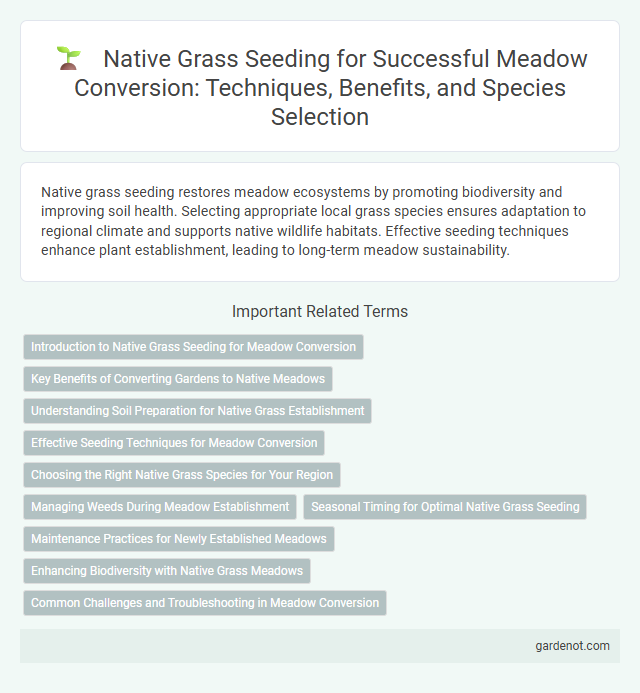Native grass seeding restores meadow ecosystems by promoting biodiversity and improving soil health. Selecting appropriate local grass species ensures adaptation to regional climate and supports native wildlife habitats. Effective seeding techniques enhance plant establishment, leading to long-term meadow sustainability.
Introduction to Native Grass Seeding for Meadow Conversion
Native grass seeding is a vital method for meadow conversion, promoting biodiversity and restoring natural ecosystems. Selecting appropriate native grass species tailored to local soil and climate conditions ensures successful establishment and long-term sustainability. Proper seeding rates and timing enhance germination rates and support resilient meadow habitats that benefit pollinators and wildlife.
Key Benefits of Converting Gardens to Native Meadows
Native grass seeding enhances biodiversity by providing essential habitats for pollinators and wildlife, contributing to ecosystem stability. Converting gardens to native meadows reduces maintenance costs through lower irrigation and mowing requirements. Establishing native grasses improves soil health by increasing organic matter and preventing erosion, promoting long-term environmental sustainability.
Understanding Soil Preparation for Native Grass Establishment
Effective soil preparation is essential for native grass seeding in meadow conversion, ensuring optimal conditions for seed germination and root establishment. This process involves removing existing vegetation, loosening compacted soil, and adjusting soil pH and nutrient levels to match native grass requirements. Properly prepared soil enhances water retention and aeration, promoting healthy growth and long-term sustainability of native grass meadows.
Effective Seeding Techniques for Meadow Conversion
Effective seeding techniques for meadow conversion prioritize selecting native grass species adapted to local soil and climate conditions, ensuring optimal germination and establishment. Preparing the seedbed by removing existing vegetation and loosening soil enhances seed-soil contact and moisture retention. Proper timing of seeding, typically during early spring or late fall, aligns with natural rainfall patterns, promoting successful growth of native grasses.
Choosing the Right Native Grass Species for Your Region
Selecting native grass species tailored to your region's climate, soil type, and precipitation patterns ensures higher success in meadow conversion projects. Utilizing local ecotype seeds enhances adaptation, drought resistance, and supports native wildlife, promoting a sustainable ecosystem. Consulting regional seed guides and extension services aids in identifying optimal species for native grass seeding efforts.
Managing Weeds During Meadow Establishment
Managing weeds during meadow establishment requires targeted native grass seeding strategies that promote rapid grass growth to outcompete invasive species. Selecting region-specific native grass varieties with robust root systems enhances soil health and ecosystem resilience while suppressing weed emergence. Consistent monitoring and strategic mowing during the critical early growth phase minimize weed seed production and support successful meadow conversion.
Seasonal Timing for Optimal Native Grass Seeding
Optimal native grass seeding requires precise seasonal timing aligned with local climate patterns, typically in early fall or spring when soil temperatures range between 50-65degF (10-18degC). Seeding during these periods enhances germination rates and seedling establishment by leveraging natural moisture availability and moderate temperatures. Avoiding extreme heat or drought periods reduces seedling stress and improves long-term meadow health and biodiversity.
Maintenance Practices for Newly Established Meadows
Native grass seeding in meadow conversion requires careful maintenance practices to ensure successful establishment and long-term sustainability. Regular monitoring for soil moisture and timely irrigation promote deep root development, while minimizing weed competition through selective mowing or targeted herbicide application supports native species growth. Periodic assessments of plant density and health guide adaptive management strategies to maintain meadow biodiversity and resilience.
Enhancing Biodiversity with Native Grass Meadows
Native grass seeding in meadow conversion significantly enhances biodiversity by providing essential habitats for pollinators, birds, and small mammals. Diverse native grasses improve soil health, water retention, and support a wide range of plant and insect species. Establishing native grass meadows fosters resilient ecosystems and promotes long-term environmental sustainability.
Common Challenges and Troubleshooting in Meadow Conversion
Common challenges in native grass seeding during meadow conversion include poor seed germination due to soil compaction, inadequate moisture, and competition from invasive species. Troubleshooting methods involve soil preparation techniques like aeration and mulching, selecting site-appropriate native grass species, and implementing timely watering schedules to enhance seedling establishment. Monitoring for pest infestations and applying targeted control measures can also improve seeding success in meadow restoration projects.
Native grass seeding Infographic

 gardenot.com
gardenot.com